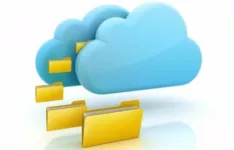When you’re looking for an HR system, one of the first decisions you’ll need to make, is whether to use cloud HR software or desktop HR software. To help you make this choice, here are the main differences between the two types of software.
What do we mean when we say “cloud” software and “desktop” software?
When we say “desktop” software – also called “on-premise” software – we are usually talking about a programme that you physically install on your computer’s hard drive. In larger organisations, we might also be talking about a system that runs on multiple computers, which you install locally on your company’s servers. In a nutshell, “desktop” software is software that you have to physically download, install, host and maintain.
When we say “cloud” software – also called web-based software, or SaaS (Software as a Service) – we are talking about a programme that you access via your internet browser. The software is installed on remote servers that are hosted and maintained by the software provider, and you will normally access it via your own unique set of login details.
“Cloud” software is becoming much more popular, and for many reasons. “Desktop” software is quickly becoming a thing of the past. But this doesn’t mean “cloud” software is necessarily right for you – before deciding which route to go down, read our summary of the key pros and cons of cloud HR software, compared to desktop HR systems.
Pros and cons of cloud HR software
There are seven very good reasons why a cloud HR system might be the best option for your business. But there are also three valid reasons why you might still wish to buy a more traditional desktop solution.
Let’s start with the benefits of choosing a cloud solution:
1) Low cost of entry.
With a cloud solution, there is no need to buy the software outright. You are not purchasing a physical copy of the software, you are only paying for a subscription to use the service – something that is typically billed on a monthly basis, with discounts for paying annually. Because of this, you can normally get started with your new system at practically zero cost. With a desktop solution, you will normally need to outright buy a physical copy of the software.
2) Low total cost of ownership.
A desktop solution comes with a range of hidden costs. For example, you’ll need to make sure you have enough disk space to host the software – for big systems, you might even require a dedicated server. You may also need to pay for an IT team to maintain your servers, and to troubleshoot problems with your software (unless you have bought a support package from the software provider). A cloud solution requires no maintenance from your side, because it is hosted on the provider’s hardware. You will normally also get some level of technical support as part of your subscription cost, meaning less financial burden on your internal IT department.
3) Faster time to market.
Because you don’t need to invest in any hardware, and because there’s no need to physically download or install your HR software, a cloud solution lets you get started straight away. This cuts down your time to market, meaning you can focus straight away on doing the things you bought the software for in the first place – such as booking holidays, managing performance, adding new starters, and creating job vacancies.You can check the buyer’s guide at peoplehr.com which covers all the essential information you need to know if you’re thinking about buying an HR system for your business based on cloud.
4) Flexible and scalable pricing.
With a desktop system, you normally buy a licence to use it – which covers you for a certain number of users. Sometimes, upgrading this licence – for example, as your business grows and needs to add more features or more users – requires a brand new installation, or time-consuming negotiations with the software provider. A web-based solution normally offers flexible pricing options that let you change your subscription at the same pace as your business needs are changing.
5) Lower risk.
With cloud HR software, you will often be paying on a rolling monthly basis. This means that if you suddenly don’t need the software – or if you find a better provider – you won’t be stuck with expensive get-out clauses, nor will you be left worrying about how much you paid upfront for the system.
6) Better security.
Security is a top priority when implementing HR software. This is because your HR department is responsible for a lot of sensitive and confidential data! When you choose a cloud HR system, you can easily verify that your provider is taking appropriate security measures to safeguard your data. However, with a desktop solution, you are responsible for securing your own systems against potential cyber criminals – something that can cost a lot of time and money.
7) Less downtime during updates.
Because a desktop solution is physically installed on your own hardware, you will need to take your system – and probably your computer network – offline while you install any updates or upgrades your provider has released. But with cloud HR software, your provider takes care of this in the background – and will normally install these updates during times when you probably won’t need to use the system, such as overnight.
Again, let me remind you that cloud HR software is not for everybody. Here are three reasons why you might prefer a desktop solution instead:
1) You don’t need to rely on the internet.
If your office is based in the middle of nowhere, and internet connectivity is unreliable, then a desktop system might give you the ability to work offline.
2) You can take responsibility for looking after your own data.
This point shows up in both lists. Let me tell you why. Not everybody is comfortable entrusting a 3rd party provider with looking after their data. If you feel that you can take stronger security measures yourself, than your HR software provider is able to, then this might be a reason to choose a desktop solution.
3) You might be able to customise your system better.
A cloud solution offers the same functionality to all its users. And while you can normally customise your package to include or exclude the features you want or don’t want, you can’t do much in the way of physically customising the system itself. If you have a team of experienced developers willing to work on a totally custom version of the HR software you buy, and if this is permitted in your software licence agreement, then a desktop solution might be the way to go.
In summary, which option is best?
As you can see, there are multiple factors that affect whether you should choose a desktop system or cloud software. In a nutshell, if you want to get started as quickly as possible, with the lowest possible cost, then a cloud solution is probably for you. If you have plans to build your own custom version of the software, or if you have a bad internet connection, then consider a desktop solution.








